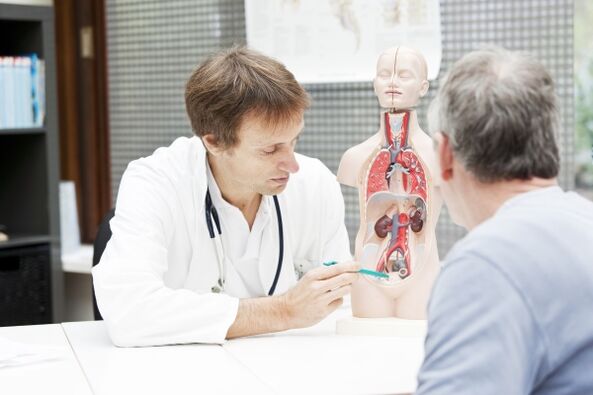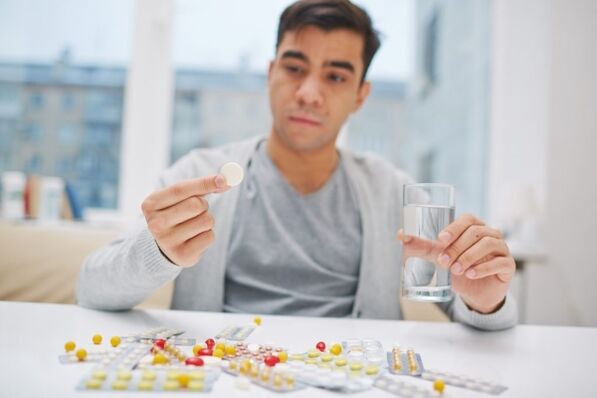If you do not want to prevent chronic prostatitis, carefully study the causes of the development of the disease, pay attention to the signs of a chronic course and be sure to read the rules of diagnosis and treatment.Read about all this in our article.
Chronic prostatitis is characterized by prolonged inflammatory processes in the prostate gland, leading to morphological and functional disorders of the prostate.It is difficult to get rid of the pathology, the complications are serious, so it is easier to prevent the disease if the causes of its development are known.
Causes
The main cause of the chronic course is untreated prostatitis, which progresses to the next phase.The following reasons and factors may contribute to this:
- Infection of the genitourinary tract by mycoplasmas, chlamydia, herpes, ureaplasmas, candida, E. coli, cytomegalovirus or trichomonas.
- Congestion in the pelvic organs, which occurs against the background of a sedentary lifestyle, impaired blood supply, poor nutrition and bad habits.
- Frequent hypothermia (the risk group includes people who surf, dive, ski, etc.).
- Prolonged abstinence from sexual relations, interrupted acts.
- Obesity due to foods rich in fat.
- Alterations in the endocrine system.
- Inflammatory processes throughout the body, especially chronic ones.
- Weak immune system.
- Injury to the genital organ.
- Constant constipation.
- Depression, stress, overwork.
Particular attention should be paid to bad habits: drinking alcohol, drugs, smoking.Harmful substances released by such products cause vasospasm, which reduces the level of blood circulation.Consequently, the nutrition of all organs deteriorates.
Symptoms
With chronic prostatitis, the prostate increases in size, which compresses the elements of the genitourinary system and narrows the urethra.As the disease progresses, the gland completely encloses the urethra, severely compressing the canal.That is why problems arise with urine production.
How to recognize chronic prostatitis:
- pain periodically occurs in the pelvis and perineum;
- discomfort when urinating and defecating;
- discharge from the urethra is observed;
- the pain extends to the thighs, testicles and anus;
- problems occur when urinating;
- intense burning and itching in the urethra;
- frequent need;
- decreased libido and erection;
- rapid ejaculation with the presence of pain;
- if an infection occurs, the body temperature rises and the condition worsens;
- after a year, infertility appears;
- the appearance of pain after normal physical activity;
- acute urinary retention and false urges;
- slow urine stream.
In the initial stages, symptoms appear slowly, but as they progress they intensify.The pain syndrome becomes very powerful and radiates to nearby organs and areas.Special attention should be paid to the process and frequency of urination.Against the background of such changes, a man experiences psycho-emotional problems, which manifest themselves as follows:
- severe anxiety;
- depression or, conversely, aggression;
- insomnia at night;
- obsessions;
- fear of sexual relations and urination;
- bad temper and irritability.

Classification
The current requirements for the classification of chronic prostatitis were developed in the 95th year of the last century.Based on this, the disease is divided into:
- Chronic bacterial prostatitis.It occurs in the context of an acute untreated bacterial disease.It manifests with typical symptoms, but with increased body temperature, chills and fever.When examined, an increased number of leukocytes and pathogenic microorganisms are detected in secretions and urine.
- Chronic prostatitis occurs more frequently.
- Asymptomatic inflammatory prostatitis is characterized by the absence of specific signs.Most of the time it is discovered by chance.
According to statistics, the most common form is nonbacterial prostatitis.Much less common (in a maximum of 10 cases out of 100) is the bacterial form.Esto se debe al hecho de que cuando se infectan, los síntomas siempre son pronunciados, por lo que el paciente, por regla general, se somete a un examen y tratamiento de manera oportuna.
Possible complications and consequences.
With chronic prostatitis, exacerbation and remission alternate, and inflammatory processes quickly destroy the prostate gland, which is why the following complications arise, which are considered the most dangerous for human life:
- Adenoma.It is formed in the prostate gland.Inflammatory processes that occur over a long period of time lead to intense cell division.At the same time, the glandular epithelium of the ducts hyperplasia, increasing the size of the organ.Against this background, benign hyperplasia develops.
- Cancerous growth in the prostate.It occurs most frequently after prostate adenoma.In an early phase of the appearance of an oncological tumor, recognizing cancer is problematic.This is due to the fact that men with chronic prostatitis experience the same symptoms.For this reason, the patient must undergo appropriate urological tests to detect prostate-specific antigen in the blood.
- Significant decrease in erection and greater impotence.This is the most common unpleasant consequence.The disease develops in a certain sequence.At first, the erection weakens slightly, after which it does not appear regularly and ejaculation occurs very quickly.In addition, sexual desire decreases and the patient feels pain during ejaculation.Then comes helplessness.
- Sterility.It occurs within a year after the chronic course of prostatitis.The fact is that chronic inflammatory processes cause a decrease in the number of sperm, slower motility of sperm and the destruction of their tails and heads.Infertility can be determined by a spermogram.
- Vesiculitis.Inflammation occurs in the seminal vesicles, which contain sperm.
- Swelling of the bladder sphincter., in the context of which acute urinary retention occurs, causing death.
- Prostatic sclerosis.The disease is manifested by the replacement of the prostate by connective tissue.That is, cords of connective tissue form, which leads to sexual dysfunction.
Other consequences:
- cyst formation;
- stones in the prostate;
- hemorrhoids;
- cystitis;
- psychological instability that needs to be treated.

If a man is diagnosed with chronic bacterial prostatitis, he should have sex only with a condom, since the disease causes his partner to become infected.Bacteria penetrate the fallopian tubes, genital tract and organs, causing diseases and female infertility.
Which doctor is treating you?
A urologist treats a man's genitourinary system.But if you visit the clinic for the first time with a similar problem, you should first visit a therapist.
As diagnostic measures are carried out, consultation with other highly specialized doctors will also be necessary: an infectious disease specialist or a psychologist, depending on the cause of the disease.
Diagnosis
At the initial visit to the andrologist, the doctor initially collects a history, which includes the following:
- study the history of urological, infectious, chronic and other diseases;
- interview the patient about lifestyle and bad habits;
- identification of factors that contribute to pathology;
- question the patient about the nature, type, and duration of symptoms.
After this, the doctor visually and palpably examines the man and refers him for further examination.
Laboratory methods
What is being done:
- Collection of fluids secreted by the urethral canal.Pathogenic microflora, mucus and leukocytes are determined.
- PCR: scraping of the urethra.Pathological agents are identified.
- Microscopic examination of prostate secretion.Macrophages, amyloid and Trousseau-Lallement bodies, and leukocytes are counted.
- Immunological examination to evaluate the level of nonspecific antibodies.
- Take blood fluid to determine PSA levels.If elevated levels are detected, a prostate biopsy is additionally prescribed, which will rule out or confirm a cancerous tumor.
Instrumental methods
Instrumental diagnoses are the following:
- Ultrasound examination of the prostate gland.Typically, the transrectal method is performed (the sensor is inserted into the rectum).The stage of the disease and its form are clarified by studying the size and echostructure of the prostate, the density and uniformity of the seminal vesicles.
- Myography of the pelvic floor muscles and urodynamic study.Neurogenic disorders and bladder outlet obstruction are determined.
- MRI and CT scan.Pathological disorders in the pelvic organs, as well as cancerous tumors, are detected.Subsequently, a differential diagnosis is established.
Differential diagnosis
Establishing a differential diagnosis is necessary, since it allows for timely identification of diseases such as:
- prostate cancer;
- bladder dysfunction of neurogenic etiology;
- disorders of the detrusor-sphincter system;
- pseudodysinegria;
- stenosis in the bladder;
- bladder neck hypertrophy;
- cystitis;
- adenoma;
- prostate sclerosis, etc.

Treatment of chronic prostatitis.
Therapy for chronic prostatitis is carried out comprehensively: medications are used, massages, physiotherapy procedures and exercises are performed.Of particular importance is the correction of the patient's own life: complete abandonment of bad habits, proper nutrition and normalization of sexual relations.In some cases the help of a psychotherapist and a psychologist is required.One treatment method cannot be used without the other, since each method complements each other.
Indications for hospitalization.
Treatment of chronic prostatitis is carried out on an outpatient basis, but some patients are subject to hospitalization, when serious complications, an advanced form of the disease and the absence of a positive result during therapy are detected.
antibiotics
Antibacterial medications are used for chronic bacterial prostatitis.The choice of drug depends on the type of pathogen.The duration of therapy is 2 to 8 weeks.Antibiotics aim to destroy the pathogenic microorganism and reduce the inflammatory process.
Different groups are used:
- Aminopenicillin group.
- Medications with cephalosporins.
- Macrolides.
- Fluoroquinolone group.
Alpha blockers
This is a group that blocks adrenergic receptors in the tissues of the pelvic organs, thereby stopping spasms in the bladder, improving the outflow of urine and facilitating the urination process.In addition, the functioning of the muscular system and sphincter is normalized.
Non-steroidal anti-inflammatory drugs
Chronic prostatitis is characterized by inflammatory processes in the prostate gland, therefore non-steroidal anti-inflammatory drugs are necessarily prescribed.They aim to relieve pain and eliminate inflammation.In addition, non-steroidals normalize the permeability of the walls of the circulatory system and restore blood circulation, due to which existing inflammatory mediators are not absorbed.
The products are used in the form of gels, tablets and injections.
Hormone therapy
If non-steroidal (non-hormonal) drugs do not have a positive effect or the patient has a hormonal imbalance, hormonal drugs are prescribed.They eliminate inflammation, help stimulate erectile function and tissue regeneration.
Restoration of blood circulation.
Since prostatitis worsens the microcirculation process in the genitourinary system, the doctor prescribes appropriate medications.When blood circulation returns to normal, regeneration processes begin and local metabolism accelerates.Consequently, the patient quickly gets rid of unpleasant symptoms.In addition, many products strengthen the walls of blood vessels and reduce blood viscosity.

Other drugs
Additionally, with chronic prostatitis, other groups of drugs are used:
- Muscle relaxants are aimed at relaxing muscles, relieving pain, accelerating blood circulation and reducing the tone of the smooth muscles of the genital organ.
- Immunomodulators correct immunological changes, but are mainly prescribed when the patient has an immunodeficiency.
- If stones are found in the prostate, the patient must take medications that regulate uric acid.
- To destroy the formed adhesions and accelerate the process of action of antibiotics and non-steroidal anti-inflammatory drugs, enzymatic drugs are prescribed.
- Vitamin and mineral therapy is indicated to strengthen the immune system.The drug is selected based on the lack of a particular vitamin or mineral.
- To restore metabolism in the prostate and regenerate damaged tissue, bioregulatory peptides are used, which are made from the prostate gland extracted from cattle.
- If the disease is accompanied by anxiety, depression, aggression and other mental disorders, sedative drugs or selective antidepressants are prescribed: tincture of valerian, motherwort.
Surgery
Surgical intervention for chronic prostatitis is rarely resorted to, only in cases where the operation is justified and does not carry the risk of complications.In addition, after surgery there is a fairly long rehabilitation period.
In what cases is surgery prescribed:
- in the absence of a positive result after complex conservative treatment;
- prostate abscess;
- tissue suppuration;
- inability to urinate:
- benign prostatic hyperplasia;
- cancerous tumors;
- other complications.
Prostatectomy
This operation involves removing the prostate and, in some cases, the lymph nodes.Radical prostatectomy according to the surgical method can be of the following types:
- robotic type - several small incisions are made in the lower abdomen, after which the prostate is removed (actions are controlled by a special robotic device);
- open type - an incision is made in the lower abdomen;
- laparoscopic: a small incision is made into which a microscope camera and instruments are inserted.
Peculiarities:
- Any type of operation is performed under general or local anesthesia (spinal anesthesia).
- The duration of the procedure is 2 to 3 hours.
- The rehabilitation period is one and a half months.
- The patient's stay in the hospital is a maximum of three days.
- The beginning of sexual life is between a month and a half and two months.
- In many cases, a urinary catheter is placed for a week.
- Complications are rare, but can be treated.
Transurethral resection of the prostate.
The surgery involves cutting the tissue surrounding the prostate, making it easier to urinate.To do this, a resectoscope is used, which is inserted into the urethra.The operation is indicated in the absence of urination, as well as for the prevention of such complications: hematuria, inflammatory processes in the kidneys and bladder, stones, urinary incontinence.
Peculiarities:
- duration of the intervention – from one hour to one and a half hours;
- stay in the clinic – 2 days;
- using a catheter – 5-7 days;
- recovery period – one and a half months;
- the beginning of sexual activity is after 6 weeks.
Abscess drainage
The operation is used for prostate abscess, which occurs as a complication.With this disease, a large amount of purulent exudate accumulates in the prostate gland, which must be removed from the body.During the operation, a puncture needle is inserted into the gland under the control of ultrasound equipment.The method resembles a puncture.
Before injection procedures, the urological surgeon palpates the prostate with the index finger by inserting it into the rectal opening.After aspiration of the pus, antiseptic treatment and drainage with rubber tubes are performed.If the patient has an extensive abscess, the pumping of purulent fluid is carried out through the perineal approach, that is, through the rectum.
Peculiarities:
- The duration of the procedure is one and a half hours;
- the maximum time spent in the drainage cavity is 72 hours;
- rehabilitation period – one month.
laser surgery
Laser treatment is an innovative and more common technique, because the operation is considered low-traumatic, safe and with minimal recovery time.During the operation, a laser instrument is installed in the urethral canal, the beam of which removes excess tissue.In this case, no incision is made.
Removal is carried out in 2 ways: ablative (excess tissue is burned) and enucleation (tissue is cut).Depending on the type of removal, laser surgery is divided into the following types:
- Photoselective vaporization: the laser vaporizes the tissue.
- Holmium laser ablation: the procedure is identical to the previous one, but a holmium laser is used.
- Holmium laser enucleation: The prostate tissue is crushed with a morcellator and then removed.
Peculiarities:
- minimum number of contraindications;
- absence of adverse reactions (bleeding, etc.);
- You can go home immediately after the operation;
- the period of use of a urinary catheter is 24 hours;
- recovery period – maximum 7 days;
- The only drawback is that it cannot be used against cancer.
What consequences can occur after surgery of any type:
- bleeding;
- temporary problems urinating;
- infection;
- urinary incontinence;
- reverse ejaculation (when sperm enter the bladder);
- tissue swelling;
- weakening of the erection;
- inguinal hernia;
- reduction in penis length (only when part of the urethral canal is removed).
To avoid complications, it is necessary to strictly follow all the surgeon's recommendations during the recovery period.You can't self-medicate.

Physiotherapy
Thanks to physiotherapy procedures, the level of inflammation is reduced, pain is relieved, tissue inflammation is eliminated, and the effectiveness of medications increases.What is used:
- phonophoresis;
- electrophoresis;
- laser therapy;
- Transrectal microwave hyperthermia.
Massage
Massage is one of the mandatory procedures in the treatment of chronic prostatitis.It is advisable to have it done by a specialist, but if this is not possible, it can be done at home (but the massage movements must be performed by another person, since the patient is in a relaxed state).
Massage contraindications:
- hyperplastic changes in the prostate;
- the presence of stones in the organ;
- venous stagnation;
- Formation of cysts and other tumors.
Procedure progress:
- The man should expose his lower body and lie down, on his side, with his knees raised to the abdominal area.
- There is another posture: knee-elbow.
- The person performing the massage should wash their hands thoroughly, wear medical gloves, and lubricate the index finger with Vaseline or another emollient.
- The masseuse inserts a finger into the anus (the man is relaxed).
- Massage the prostate gland with gentle strokes.
- The duration of the procedure is 2 to 5 minutes.
If a man lives alone and cannot visit a massage therapist, special urological massagers can be used.The treating urologist will help you choose the optimal model for you.
Diet therapy
A patient with prostatitis must follow a special diet to prevent the formation of cholesterol plaques, constipation and increased gas formation.Dishes will need to be steamed or boiled.Baking is allowed, but without using oil.
Authorized products:
- seafood;
- pumpkin seeds;
- fruits and vegetables that do not cause gas;
- porridge;
- fermented dairy products;
- dried fruits;
- lean meats and fish.
Prohibited products:
- any beans;
- cabbage;
- carbonated drinks;
- alcohol;
- spicy and salty dishes;
- strong tea and coffee;
- yeast baked goods.

Folk remedies
Traditional medicine recipes are used exclusively in agreement with the andrologist, since many of them may have contraindications.
Recipes:
- Eat 30 to 40 pumpkin seeds a day, preferably on an empty stomach.
- You can drink pear compote, but only without adding sugar.
- Take a medicinal bath three times a week.To do this, make a decoction of herbs in equal proportions: chamomile, sage, pine needles, calendula.Prepare according to the standard scheme (for a glass of water: 2 tablespoons of the mixture).Pour into the bath, add sea salt in free proportion and take a sitz bath for 15 minutes.The water temperature does not exceed 40 degrees.
- Use parsley: add it to salad, squeeze the juice and drink it.You can also use the seed part.
- Make your own rectal suppositories.To do this, combine propolis in equal proportions with butter and cocoa powder.Use your hands to form a candle, wrap each suppository in plastic wrap and place in the refrigerator.Every night before bed, administer 1 suppository for 30 days.
Forecast
If we talk about the prognosis, then it directly depends on many circumstances: the degree of negligence, the form of the disease, the appropriateness of therapy and the behavior of the patient himself.If you notice the development of a chronic form and carry out treatment in a timely and correct manner, then the prognosis is quite favorable.
However, you should know that in very rare cases a complete cure of the disease occurs, but it is possible to achieve a stable remission, during which no symptoms appear.
Throughout his life, the patient will have to strictly comply with preventive measures, periodically undergo examinations and take medications.
Preventive measures
To prevent the development of chronic prostatitis and its exacerbation during remission, simple rules should be followed:
- contact a urologist in a timely manner;
- lead a healthy and active lifestyle (eliminate bad habits, practice moderate sports);
- eat well;
- having sex should be regular, at least 3 times a week;
- monitor the state of the immune system;
- don't be too cold;
- exclude casual sex;
- train the muscles of the genitourinary system: do special exercises.
If you have chronic prostatitis, don't be alarmed, because this is not a death sentence.With the right therapeutic approach and regular visits to the andrologist, you can lead an active sexual life without experiencing unpleasant symptoms.













